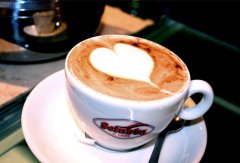Enjoy doing clumsy things: baking technology in the 19th century

Is it the change of science and technology, the change of society, or the change of society that promotes the change of science and technology? There is no clear answer to this question. But what we can be sure of is that the two have been moving forward at the same time, transforming coffee roasting in the 19th century from a large-scale, private form to a large-scale enterprise that uses advertising and mass marketing skills. The stability of the baking mode of coffee beans marketed by brands can only be achieved through more accurate baking technology.
During the Industrial Revolution, a variety of novel inventions continued to emerge, and some diligent R & D companies focused on the same machine to produce every coffee drink needed in the 19th century, from baking to brewing on the same machine. In the industrialized countries at that time, patent applications for all kinds of new coffee brewers, bean grinders and bean roasters were constantly sent to the offices of patent inventions, although only a small number of these patents had a significant influence, but in this era, these patents have made a great contribution to the evolution of baking technology.
During this period, coffee beans were still roasted with cylindrical or ball-shaped baking equipment, but these devices became larger and larger, from small baking at home or in small cafes to large baking plants. There is a picture of the interior of a bakery in the United States in the mid-19th century on page 35 for your reference.
The baking drums of this era were mechanically driven. At the beginning, they were powered by steam, but by the end of the 19th century, they were driven by electricity. The source of fire has also changed from burning firewood and coal to burning natural gas. At the end of the 19th century, there was also a dispute between "direct gas fire baking" and "indirect gas fire baking". The former is to let gas and flame directly into the baking room to come into contact with coffee beans, the latter is not to let gas and flame directly into the baking room, but to let the flame heat the baking room, and the hot air enters the baking room indirectly through the blower.
Then there are two more in-depth technological innovations: (1) precise temperature control / time; and (2) uniform baking so that each coffee bean has the same baking degree.
Let's take a look at the first innovation in time control. At that time, as the baking drum and the baking sphere of the bean roaster were getting larger and larger, and the batch baking quantity was also getting larger and larger, it became more and more difficult to cool the coffee beans, because after the coffee beans left the baking environment, the beans still contained heat and could continue to be baked (this phenomenon is called "self-baking").
In the early 19th century, to make the roasting of coffee beans more stable, the solution was to "pour coffee beans out of the baking room faster and more easily." For example, the "Carter Pull-Out" on page 35 is a roaster designed with this concept. Its selling point is that the baking drum can be pulled out of the fire quickly and the coffee beans can be poured out very easily. However, it can also be observed from the picture that the poured coffee beans still need to be manually stirred to accelerate cooling, both of which can effectively reduce the temperature on the surface of the coffee beans. at the same time, it takes away the smoke from the freshly roasted beans.
Another innovation at the end of the 19th century addressed the technical question of "how to make baking more uniform". At the beginning of the 19th century, most baking drums or spherical roasters were very simple hollow bakeries in which coffee beans were squeezed together and were not easy to "transposition". As a result, some coffee beans located at the bottom have been continuously heated and scorched, while those at the top are not easily heated. In addition, the oil spilled from the roasted coffee beans will form an oil film on the inner surface of the baking room, which will often stick the coffee beans and fix them in a certain position in the metal baking room.
Also in the middle of the 19th century, the structure of mixing blade or mixing blade was added to the baking chamber to improve the uniformity of baking. In 1864, Jabez Burns, a well-known baking technology leader in the United States, even solved the problem of "dropping beans" (short for pouring out and cooling coffee beans after baking is finished). The company has designed two groups of spiral blades fixed inside the baking chamber to allow the roasted coffee beans to be transposed up and down in the baking room. after the baking is completed, the operator only needs to open the opening in the baking room. the coffee beans inside will be automatically pushed out and poured into the cooling plate.
But by the end of the nineteenth century, there were more efficient ways to improve baking uniformity. In order to assist the uniformity of heating, in addition to the direct heat source generally applied to the surface of the baking room, use a fan or blower to send hot air to the inside of the baking room. the function of this hot air is to properly cool coffee beans ("cooling coffee beans properly" in this place is not to lower the temperature hormones of coffee beans inside, but to make use of the principle of air convection. To avoid smoldering coffee beans in the baking drum is a way to avoid a sharp rise in temperature.) During the baking process, the coffee beans are constantly stirred by the leaves, and the hot air flow continues to flow in the baking chamber, which means that the coffee beans come into contact with hot air more frequently than with the metal wall of the baking room. this structure improves the baking stability and the baking speed of each batch. In addition, for the heating part, the original design of heating only under the baking drum is renamed so that the whole baking drum is heated uniformly around the baking drum. this design is to change the baking drum wall with only one layer into the baking drum with two inner and outer layers. the heated air outside the baking drum is introduced into the loop between the two walls.
In general, the basic structure of a typical drum bean dryer must include the following equipment:
1. Uniform conduction of gas heat source.
two。 Accurate and fast bean design.
3. The blade design inside the baking drum.
4. A blower that draws heated air into the baking chamber to stabilize the heating range.
5. A cooling fan that blows cold air at room temperature under the cooling tray.
These basic equipment are still the main functional devices of most small drum bean dryers today, and you can see the relevant roaster diagrams and instructions on pages 60-61.
Of course, in addition to this basic structure, there are many other basic structural versions, such as bean dryers at the turn of the century that move the source of gas to the inside of the baking drum. And most modern large-scale bean baking equipment will be equipped with a water mist cooling device, so that a large number of roasted coffee beans in each batch can quickly cool down. This cooling method, known as "water mist cooling method" (Water Quenching), is another effective cooling method in addition to the "air cooling method" (Air Quenching) mentioned in this book.
Although there have been so many changes over the decades, some bean dryers have been constructed for decades, and old-fashioned bean dryers continue to be used today, such as in Japan, Brazil and some parts of the United States. bean dryers fueled by wood or charcoal continue to be used. Customers in these places pay special attention to the charcoal-burning and smoky aroma levels of this kind of bean dryer.
However, today's drum baking machine is still based on the design of indirect heating and using blower to introduce hot air, and only the largest bean baking factory does not use such a baking mechanism.
Important Notice :
前街咖啡 FrontStreet Coffee has moved to new addredd:
FrontStreet Coffee Address: 315,Donghua East Road,GuangZhou
Tel:020 38364473
- Prev

Roasting coffee beans with technology-modified ruts
Although coffee drinking and growing methods developed dramatically in the seventeenth and eighteenth centuries, progress in roasting was very poor. The most common method of roasting at the time was to follow the Middle Eastern method of simple roasting: placing green coffee beans in an iron pan, then moving to a fire and roasting, stirring until the coffee beans were evenly mixed.
- Next

Innovative baking technology in the 20th century: the baking method using purely hot air flow
Innovative baking technology in the 20th century: pure use of hot air baking, of course, how could there be no innovative baking technology in this era of the twentieth century? In the middle of the twentieth century, there were two major milestones in the evolution from direct and indirect fire baking to hot air baking. In 1934, Garbeth Burns developed a machine called Thermalo
Related
- Beginners will see the "Coffee pull flower" guide!
- What is the difference between ice blog purified milk and ordinary milk coffee?
- Why is the Philippines the largest producer of crops in Liberia?
- For coffee extraction, should the fine powder be retained?
- How does extracted espresso fill pressed powder? How much strength does it take to press the powder?
- How to make jasmine cold extract coffee? Is the jasmine + latte good?
- Will this little toy really make the coffee taste better? How does Lily Drip affect coffee extraction?
- Will the action of slapping the filter cup also affect coffee extraction?
- What's the difference between powder-to-water ratio and powder-to-liquid ratio?
- What is the Ethiopian local species? What does it have to do with Heirloom native species?

